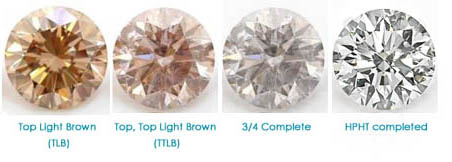
When a woman reflects about her glistening HPHT (high-pressure high-temperature) diamond and remembers how fortunate she was to receive it, she thinks about the time her heart skipped in rhythm when she heard those tender, loving words, "Will You Marry Me?" In this article, we will discuss how this magnificent journey actually started much earlier. An HPHT diamond set in an engagement ring is a continuance of an astounding multi-billion year process. The diamond is a crystallized morsel of eternity, and the life we behold, here on earth.
An HPHT diamond is born from the earth, as natural as the Hope diamond or any of the diamonds in the British crown jewels. There are types of diamonds that sprinkled from the sky in meteorites and micro-diamonds that formed in the fireworks display of asteroids initiating contact with the Earth. However, an HPHT diamond originates from a low-nitrogen, brownish diamond (rare Type IIa), found in lush, exotic and uniquely resource-rich locations, such as Australia.
Let’s step back to gain perspective. Carbon, the principle component of diamonds, only existed in any great abundance when several generations of stars sparkled into being and united with the planet. This phenomenon occurred when the planet came into being four billion years ago. This fusion of land and amazing atmospheric conditions produced enough carbon that we enjoy today in local abundance.
A single HPHT diamond's age ranges from one billion to three billion years. The prehistoric Cambrian event that created carbon-rich life is the source of what humans throughout time regard as the most beautiful and valuable gemstone—the natural diamond. Geologic tectonic processes formulated their carbon-rich resources in the earth’s surface by massive amounts. Here, within the lushest regions of the continental plates, exists the perfect conditions for growing diamond crystal. Under these natural HPHT conditions, the carbon from early life crystallizes into the most resilient and awe-inspiring of all gems. Volcanoes then reveal this carbon back to the surface in the form of the most adored and rare, sparkling masterpiece of natural art—the diamond.
Because rare, Type IIa brown diamonds are the embodiment of superior strength and structure, they are the only diamonds suitable for HPHT processing. The color originates from microscopic birthmarks in the crystal structure, rather than impurities. For the brown Type IIa diamond, the same conditions to transform it to a top-shelf diamond now can be achieved very quickly with advances in technology, while still preserving the natural, permanent properties of the diamond.
That's where HPHT processing comes in. Expert gemologists apply precise amounts of heat and pressure to Type IIa diamonds to essentially recalibrate the molecular structure to present a highly-desirable white or colorless grade diamond. The result of the HPHT process transforms the diamond into a sparkling, clear-as-water diamond that any woman would be proud to feature. The HPHT process simply completes what Mother Nature started, using the same heat and pressure she uses to form these dazzling diamonds.
An HPHT diamond travels through great distance and time to find its place with the perfect woman. It is truly a natural, lifetime diamond. To see how much joy an HPHT diamond will bring you, Contact us for a no-obligation preview in the comfort of your own home.
